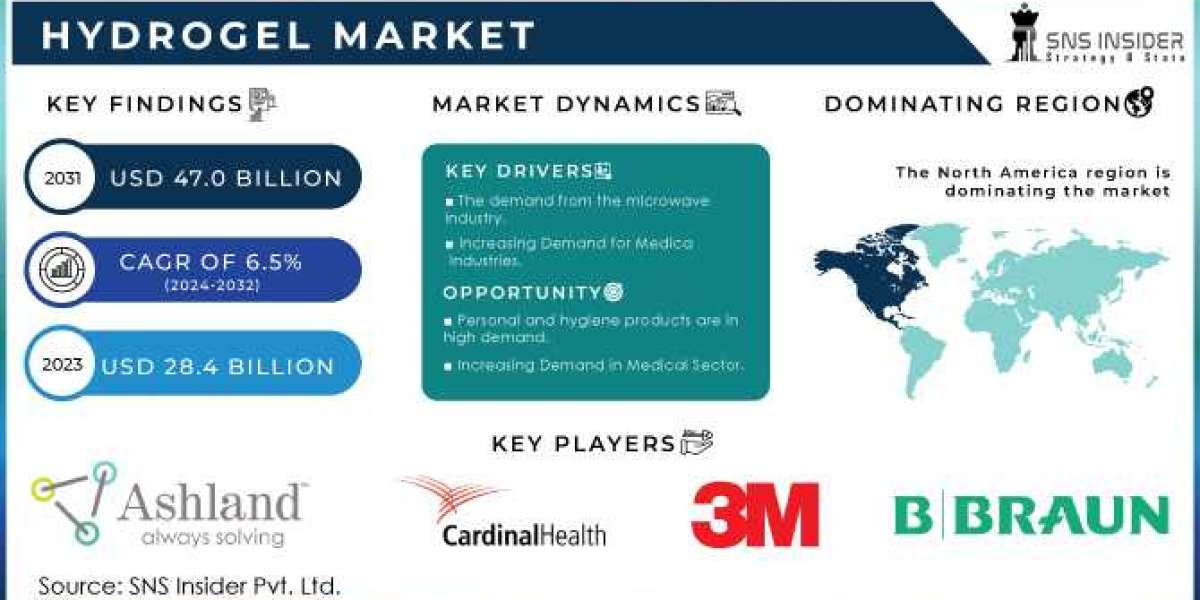The Hydrogel Market is forecasted to grow considerably, with a 6.5% CAGR from 2024 to 2031. Market insights reveal that the market, valued at USD 28.4 billion in 2023, will reach USD 47.0 billion by 2031, fueled by innovations and increasing applications in multiple industries.
The Hydrogel Market is set to experience substantial growth in the coming years, with a compound annual growth rate (CAGR) of 6.5% from 2024 to 2031. According to recent market analysis, the market size, valued at USD 28.4 billion in 2023, is expected to soar to an impressive USD 47.0 billion by 2031. This significant growth is driven by advancements across various sectors, a rising demand for hydrogel-based products, and increasing applications in numerous industries.
Market Overview
Hydrogels are three-dimensional, hydrophilic polymer networks capable of holding large amounts of water. They are widely used due to their unique properties such as high water content, flexibility, biocompatibility, and versatility. The market is segmented by raw material type, composition, form, application, and region, offering a comprehensive view of its dynamic landscape.
Get Full Free PDF @ https://www.snsinsider.com/sample-request/1482
Segmentation and Key Drivers
Raw Material Type:
Natural: Derived from natural sources, these hydrogels are increasingly preferred due to their biocompatibility and biodegradability. Common natural hydrogels include those made from agarose, alginate, and chitosan.
Synthetic: Synthetic hydrogels, such as those made from polyacrylamide and polyethylene glycol, are favored for their controllable properties and durability.
Hybrid: Hybrid hydrogels combine natural and synthetic materials to leverage the benefits of both types, enhancing their performance in various applications.
Composition:
Polyacrylate: Widely used in personal care products and agriculture, polyacrylate hydrogels are known for their superabsorbent properties.
Polyacrylamide: Commonly used in water treatment and agriculture, polyacrylamide hydrogels offer excellent moisture retention and soil conditioning properties.
Silicon: Silicon-based hydrogels are primarily used in medical applications, such as contact lenses, due to their oxygen permeability and comfort.
Others: Other compositions, including protein-based and polysaccharide-based hydrogels, are utilized in specialized applications.
Form:
Amorphous: These hydrogels lack a defined shape and are used in wound care for their conformability and ease of application.
Crystalline: Crystalline hydrogels are structured and offer high strength, making them suitable for various industrial applications.
Semi-Crystalline: Semi-crystalline hydrogels provide a balance between flexibility and strength, used in diverse applications from medical to industrial.
Application:
Wound Care: Hydrogels are extensively used in wound care products due to their ability to maintain a moist environment, promote healing, and provide pain relief.
Contact Lens: The contact lens industry relies on hydrogels for their moisture-retaining properties and comfort.
Drug Delivery: Hydrogels are increasingly used in controlled drug delivery systems, offering sustained and targeted release of therapeutics.
Agriculture: In agriculture, hydrogels are used for soil conditioning and water retention, enhancing crop yield and reducing water usage.
Personal Care Hygiene: Hydrogels are integral to personal care products such as diapers and sanitary napkins, owing to their absorbency and comfort.
Others: Additional applications include tissue engineering, diagnostics, and food packaging.
Regional Insights
The Hydrogel Market is analyzed across various regions, each exhibiting unique growth patterns and opportunities:
North America: Dominating the market, North America’s growth is driven by robust research and development activities, a strong healthcare sector, and increasing adoption of hydrogel-based products in personal care and agriculture.
Europe: Europe is experiencing substantial growth due to the presence of leading healthcare companies, high demand for advanced wound care products, and significant investments in biotechnology.
Asia-Pacific: The Asia-Pacific region is projected to witness the fastest growth, driven by rapid industrialization, increasing healthcare expenditure, and expanding agricultural activities.
Latin America: The market in Latin America is growing steadily, with significant contributions from the personal care and agriculture sectors.
Middle East Africa: This region is also poised for growth, supported by investments in healthcare infrastructure and increasing adoption of hydrogel technologies in agriculture and wound care.
Market Drivers and Trends
Several factors are contributing to the significant growth of the Hydrogel Market:
Advancements in Medical Applications: The increasing use of hydrogels in medical applications such as wound care, contact lenses, and drug delivery systems is a major driver of market growth. The biocompatibility, flexibility, and moisture-retaining properties of hydrogels make them ideal for these applications.
Growing Demand in Personal Care Products: The personal care industry’s demand for hydrogels, particularly in products like diapers and sanitary napkins, is rising due to their high absorbency and comfort.
Agricultural Benefits: In agriculture, hydrogels are used for water retention and soil conditioning, helping to improve crop yield and reduce water usage. This is particularly important in regions facing water scarcity.
Technological Innovations: Continuous advancements in hydrogel technology, including the development of hybrid and smart hydrogels, are expanding their applications and driving market growth.
Aging Population: The growing aging population worldwide is increasing the demand for advanced wound care products, which in turn drives the hydrogel market.
Future Prospects and Challenges
The Hydrogel Market is expected to continue its upward trajectory, supported by ongoing research and development activities, rising demand for hydrogel-based products, and the expansion of end-use industries. However, the market faces challenges such as high production costs and stringent regulatory requirements, which may impact growth.
Conclusion
The Hydrogel Market is on the brink of transformative growth, offering significant opportunities for stakeholders across various sectors. With a projected market size of USD 47.0 billion by 2031 and a robust CAGR of 6.5% from 2024 to 2031, the future of this market looks promising. As industries continue to prioritize efficiency, sustainability, and performance, hydrogels are set to play a crucial role in shaping the future of advanced manufacturing and healthcare.
Contact Us:
Akash Anand – Head of Business Development Strategy
Phone: +1-415-230-0044 (US) | +91-7798602273 (IND)
Read Related Reports:
Medical Textile Industry Market Size














